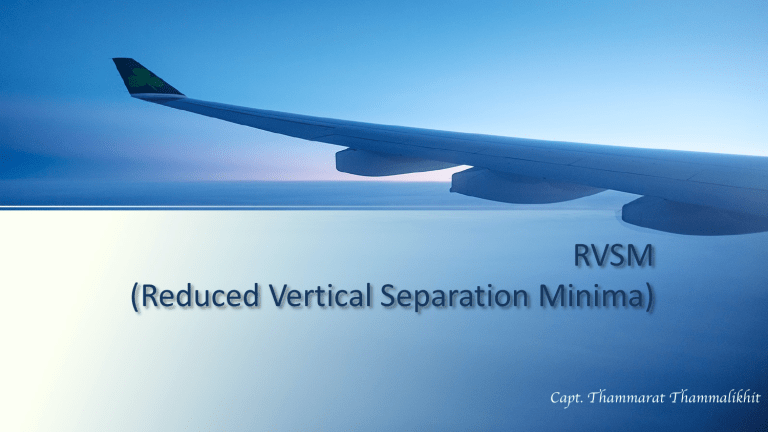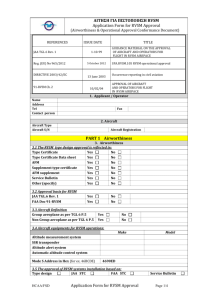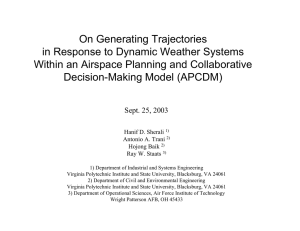
RVSM (Reduced Vertical Separation Minima) Capt. Thammarat Thammalikhit Outline • General • Operation Procedures • Contingency Procedures General Introduction • RVSM airspace is defined as any airspace or route where the aircraft are separated vertically by 1000 ft between FL290 and FL410 inclusive (instead of 2000 ft). • The objective of RVSM is to increase the route capacity of saturated airspace while keeping at least the same level of safety. This can be achieved by imposing stringent requirements on equipment and training of personnel, flight crews and ATC controllers. As part of the RVSM program, the altitude keeping performance of the aircraft is monitored to verify that airspace users are applying the approved criteria effectively and that the overall safety objectives are being maintained. General RVSM Benefits Under the RVSM implementation program the following benefits are accruing: • Improved operations/efficiency •Greater availability of the more fuel-efficient altitudes •Greater availability of the most fuel-efficient tracks or routes •Increased probability that an operator will be cleared onto the desired •track or altitude •Enhanced controller flexibility to manage traffic through an increased •number of available altitudes General Background North Atlantic (NAT) RVSM implementation RVSM was first implemented in NAT on March 27, 1997. Phase I of North Atlantic (NAT) RVSM was implemented from FL 330 to FL 370, inclusive, within Minimum Navigation Performance Specifications (MNPS) airspace. Phase II of NAT RVSM expanded the MNPS airspace from FL 310 to FL 390, inclusive, on October 8, 1998. All aircraft that had not been approved for RVSM operations were excluded from this airspace. Ongoing system performance monitoring and review of aircraft approvals continued during Phase II of NAT RVSM implementation. Phase III of the NAT RVSM, which led to full implementation, expanded the NAT MNPS airspace from FL 290 to FL 410. The Phase III implementation was concurrent with the implementation of RVSM in Europe on 24th January 2002. General PACIFIC RVSM Operational Implementation Plan RVSM was implemented in Pacific Oceanic airspace between FL290 and FL390 (inclusive) on February 2000. ICAO RVSM Implementation Task Force had agreed on the operational plan for the implementation of RVSM in the Western Pacific/South China Sea area, in conjunction with the revised ATS route structure for the South China Sea. The meeting agreed that RVSM could be applied between FL290 and FL410 on the revised route structure, using the single alternate flight level orientation scheme for the assignment of RVSM levels. The meeting also agreed that only RVSM-approved aircraft should be permitted to flight plan at the RVSM levels, to avoid a mixed environment of operations. General RVSM Approval Overview Prior to the granting of an RVSM approval the aircraft must satisfy the following requirements: 1. the aircraft must be eligible for RVSM (i.e. must satisfy the vertical navigation performance) 2. the instituted appropriate procedures in respect of continued airworthiness (maintenance and repair) practices and programs. 3. the instituted appropriate flight crew procedures and training for operations in RVSM airspace. 4. the instituted RVSM monitoring programs. 5. The RVSM approval process consists of two discrete approvals, an airworthiness approval and an operational approval. General Height Monitoring Systems There are 3 independent height monitoring systems currently in use. These are: 1.GPS Monitoring Unit (GMU). This is a portable carry on device used to estimate the ASE of a single flight for one aircraft. The advantage is that the aircraft can be monitored almost anywhere 2. Height Monitoring Unit (HMU). An HMU is a fixed ground based system which with one central and four outer receiving stations. 3. ADS-B Height Monitoring Systems (AHMS). An Automatic dependent surveillance broadcast (ADS-B) Height Monitoring System (AHMS) is a height monitoring system that utilizes data from an existing ADS-B network. General It is important to ensure that the monitoring data is correlated to the correct aircraft. Height monitoring systems only receive the aircraft ICAO 24-bit aircraft identifier. It is necessary to compare the 24- bit aircraft address to the address provided by the State in the RVSM approval data. All operators of RVSM approved aircraft are required to participate in the RVSM height monitoring programme. The principle purposes of the long term height monitoring programme are to verify long term ASE stability and the efficacy of an operator’s continued airworthiness programme Operation Procedures Flight planning During flight planning, the flight crew and dispatchers, if applicable, should pay particular attention to conditions which may affect operation in RVSM airspace. These include, but may not be limited to : (a) verifying that the aircraft is approved for RVSM operations (b) block 10 (equipment) of the ICAO flight plan should be annotated with the letter “W” for filing in RVSM airspace. (c) reported and forecast weather conditions on the route of flight (d) minimum equipment requirements pertaining to height-keeping systems (e) Traffic Alert and Collision Avoidance System (TCAS) equipage. TCAS equipage requirements are contained in each AIP or regional supplementary procedures. (f) if required for the specific aircraft group; accounting for any aircraft operating restrictions related to RVSM airworthiness approval. Operation Procedures Pre-flight procedures Accomplish the following actions during pre-flight. (a) Review aircraft logs and forms to ascertain the condition of equipment required for in the RVSM airspace. (b) The external inspection of aircraft, pay particular attention to the condition of static sources, the condition of the fuselage skin near each static source or the other component affecting altimetry system accuracy. (c) Before takeoff: • The aircraft altimeters should be set to the altimeter setting (QNH) and should display a field elevation The difference between the field elevation and the display on the altimeters should not exceed 75 ft. • The 2 primary altimeters should also agree within limits specified by the Airplane Flight Manual (AFM), (d) Equipment required for flight in RVSM airspace should be operational, and indications of malfunction should be resolved. Operation Procedures Procedures before RVSM airspace entry The following equipment should be operating normally at entry into RVSM airspace otherwise request a new clearance so as to avoid flight in RVSM airspace. : (a) 2 altitude measurement systems, as defined by the RVSM (b) Automatic altitude-keeping device(s); Note.— Redundancy requirements for altitude-keeping devices should be established by regional agreement after an evaluation of such criteria as mean time between failures, length of flight segments and availability of direct pilot controller communications and radar surveillance. (c) at least 1 altitude-reporting transponder (For ACAS system according to annex 10 Vol. IV) ; and (d) one altitude-alerting device; Operation Procedures In-flight procedures Generally, flight crew operating procedures in RVSM airspace are no different from those in any other airspace; however, the continuity of RVSM operations will require periodic review of procedures specific to a region, e.g. contingency procedures crews should be reminded to minimize the deviations from the cleared flight level. and should be reminded of the importance of adhering to the following in-flight procedures: (a) In level cruise, except in contingency or emergency situations, the aircraft should not intentionally depart from CFL without a positive clearance from ATC. (b) During cleared transition between levels, the aircraft shall not be allowed to overshoot or undershoot the CFL by more than 150 ft (45 m). Note : It is recommended that the level off be accomplished using the altitude capture feature of the automatic altitude-control system, if installed. High rates of climb or descent may result in nuisance TCAS alerts on older TCAS equipment (TCAS 7.0) when in vicinity of other traffic or in areas of high traffic density. For this reason it may be advisable to reduce the rate of climb/descent to less than 1,000 ft/min within 1,000 ft of the cleared flight level. Operation Procedures In-flight procedures (c) An automatic altitude-control system should be operative and engaged during level cruise, adherence to cruise altitude should be done by reference to one of the two primary altimeters. (d) The altitude-alerting system should be operational. (e) At intervals of approximately 1 hour, make cross-checks between the primary altimeters and the stand-by altimeter. A minimum of two primary altimeters should agree within 200 ft (60 m). (Otherwise ,notified to ATC). Note the difference between the primary and stand-by altimeters for use in contingency situations. (h) Crew should ensure the autopilot used and the transponder selected use the same air data source for altitude information. Operation Procedures Operation Procedures Equipment failures ATC shall be informed as soon as practicable of the following equipment failures : (a) failure of all automatic altitude-keeping devices on board the aircraft; (b) loss of redundancy of altimetry systems, or any part of these, on board the aircraft; (c) failure of all altitude-reporting transponders; (d) loss of thrust on an engine necessitating descent; and (e) any other equipment failure affecting the ability to maintain CFL; Operation Procedures Post flight In making maintenance logbook entries against malfunctions in height-keeping systems, The pilot should detail the actual defect and the crew action taken to try to isolate and rectify the fault. Note the following information when appropriate: (a) primary and standby altimeter readings. (b) altitude selector setting. (c) subscale setting on altimeter. (d) autopilot used to control the airplane and any differences when the alternate system was selected. (e) differences in altimeter readings if alternate static ports selected. (f) use of air data computer selector for fault diagnosis procedure. (g) transponder selected to provide altitude information to ATC and any difference if alternate transponder or altitude source is manually selected. Contingency Procedures Weather deviation procedures The following procedures are intended for deviations around adverse meteorological conditions. When the pilot initiates communications with ATC, a rapid response may be obtained by stating "WEATHER DEVIATION REQUIRED" to indicate that priority is desired on the frequency for ATC response. When necessary, the pilot should initiate the communications using the urgency call "PAN PAN" (preferably spoken three times). The pilot shall inform ATC when weather deviation is no longer required, or when a weather deviation has been completed and the ACFT has returned to its cleared route. Contingency Procedures Weather deviation procedures Contingency Procedures Contingency Procedures Contingency Procedures Contingency Procedures



